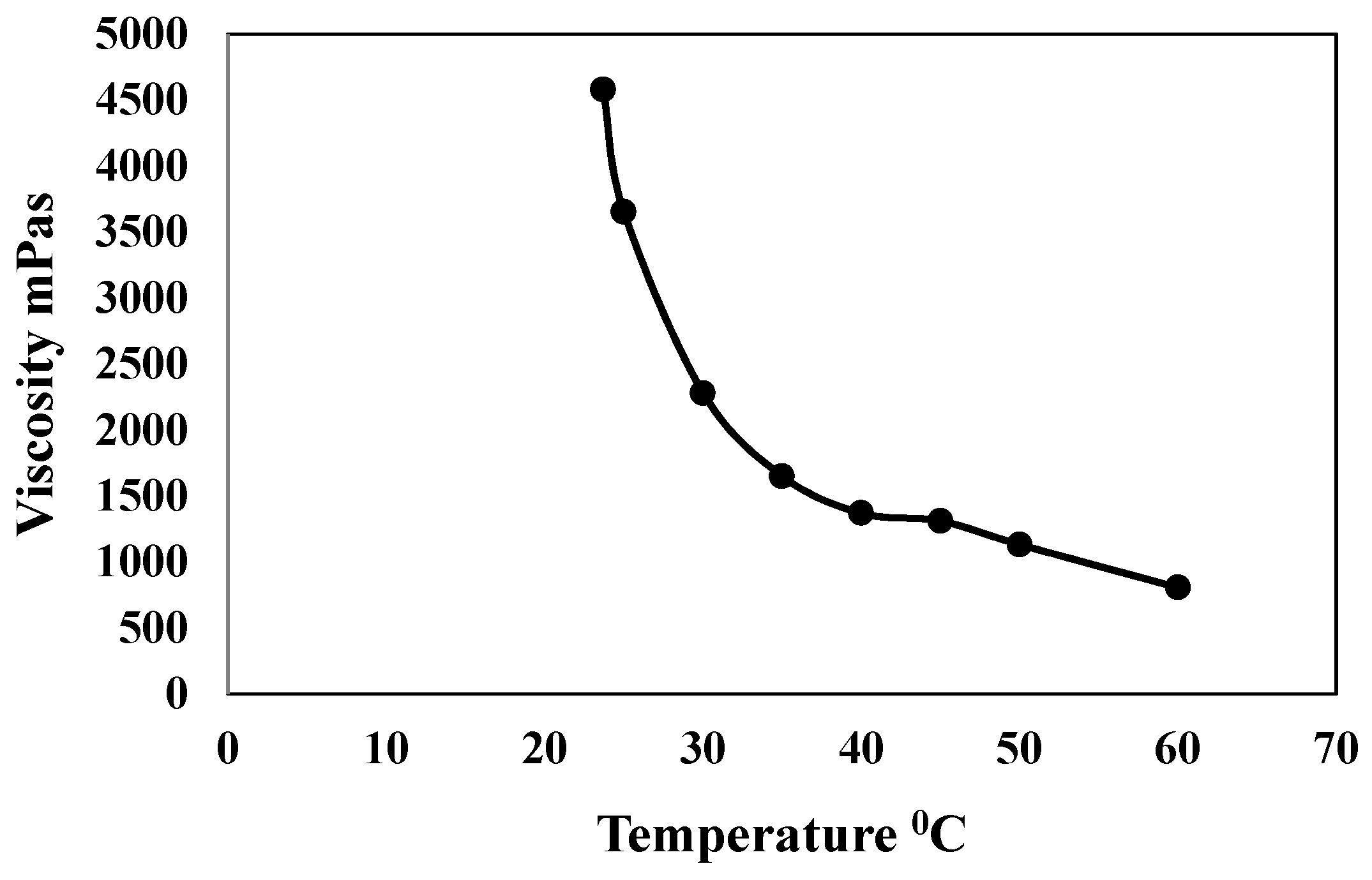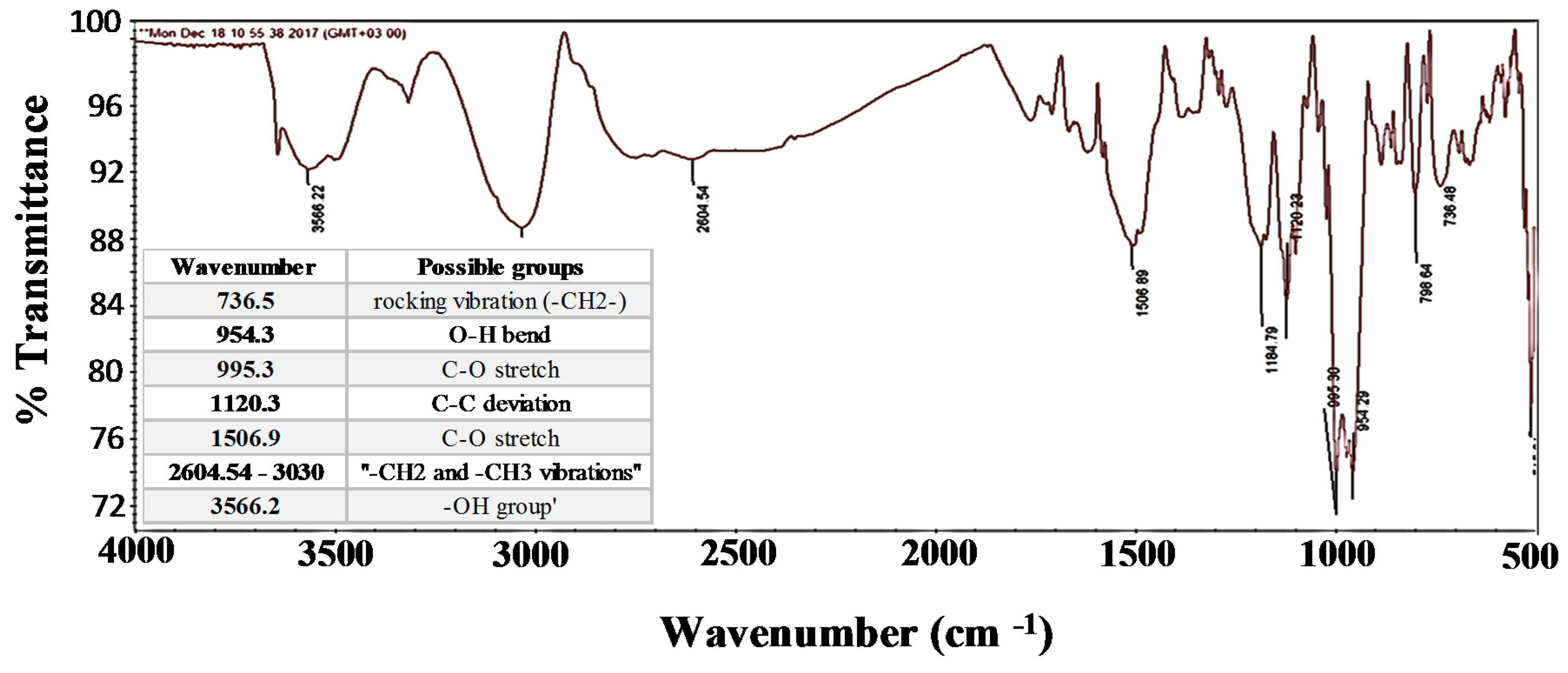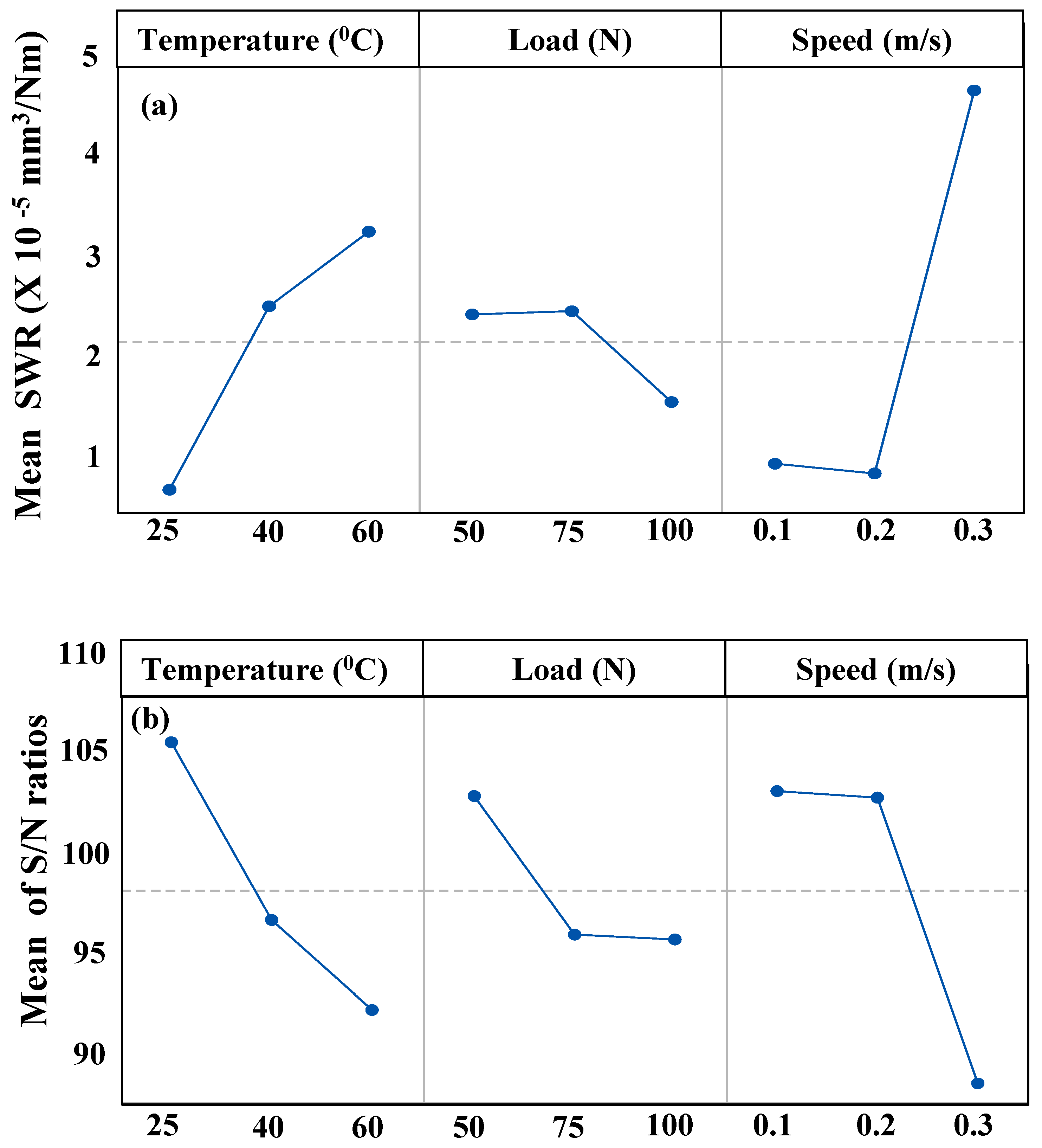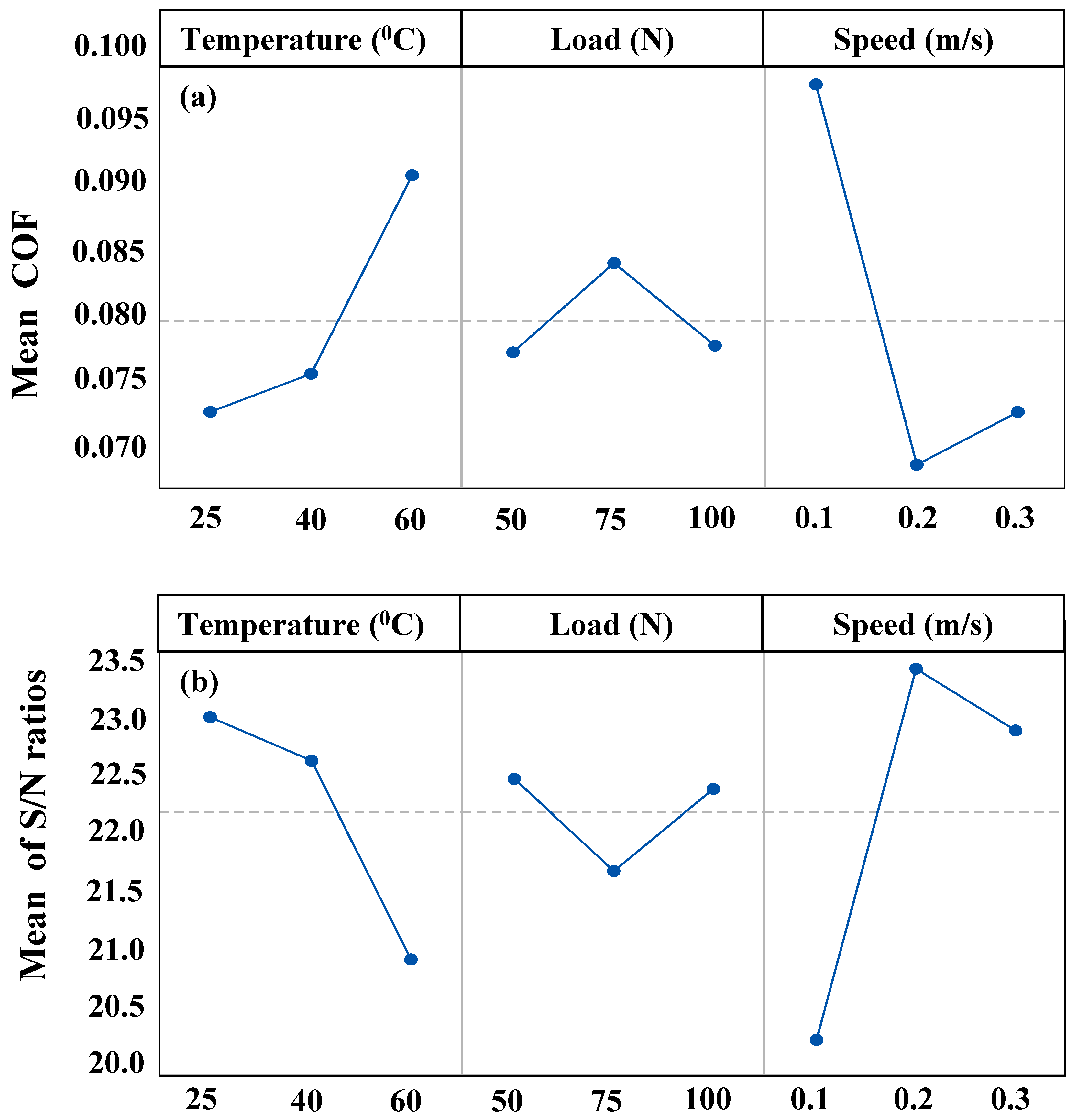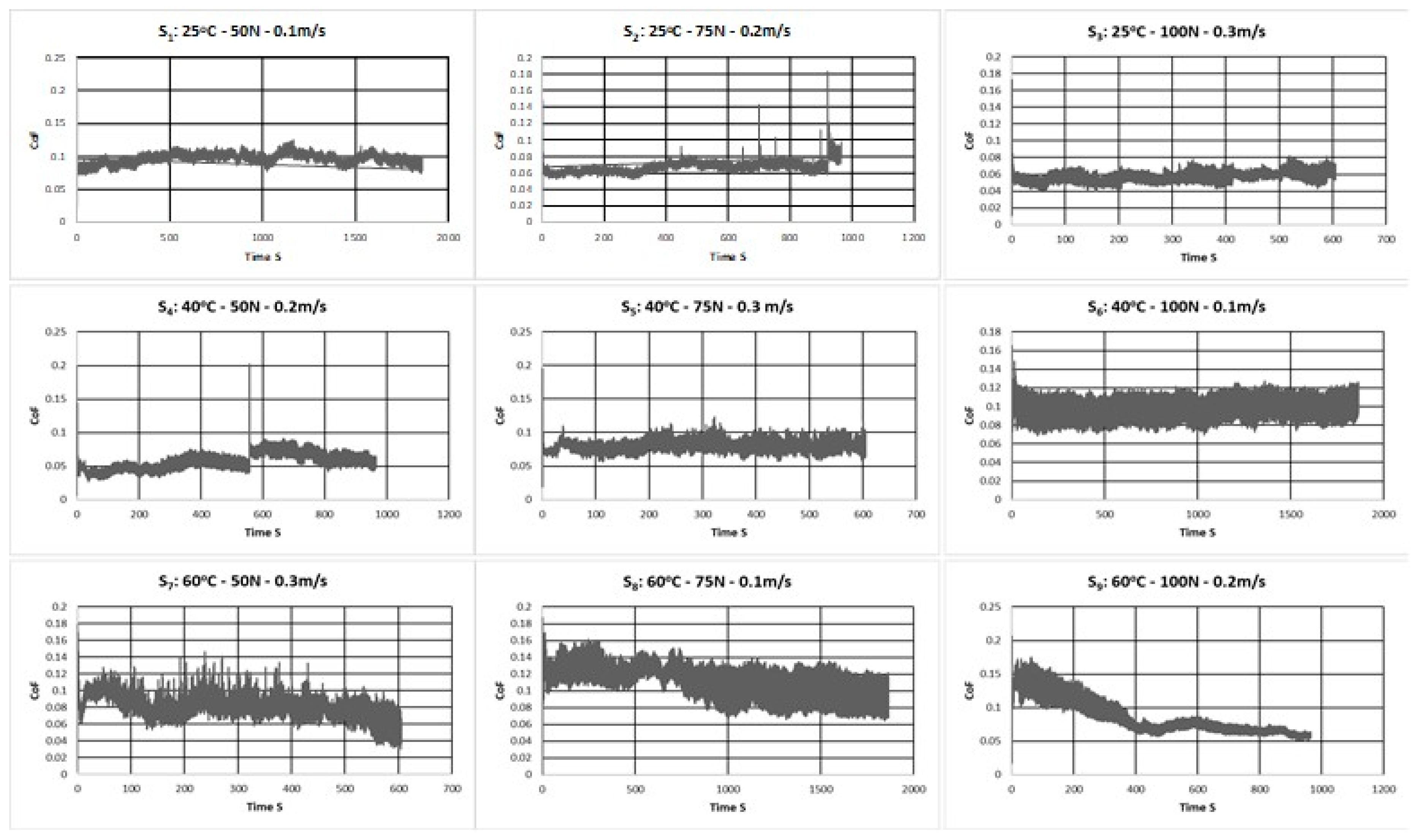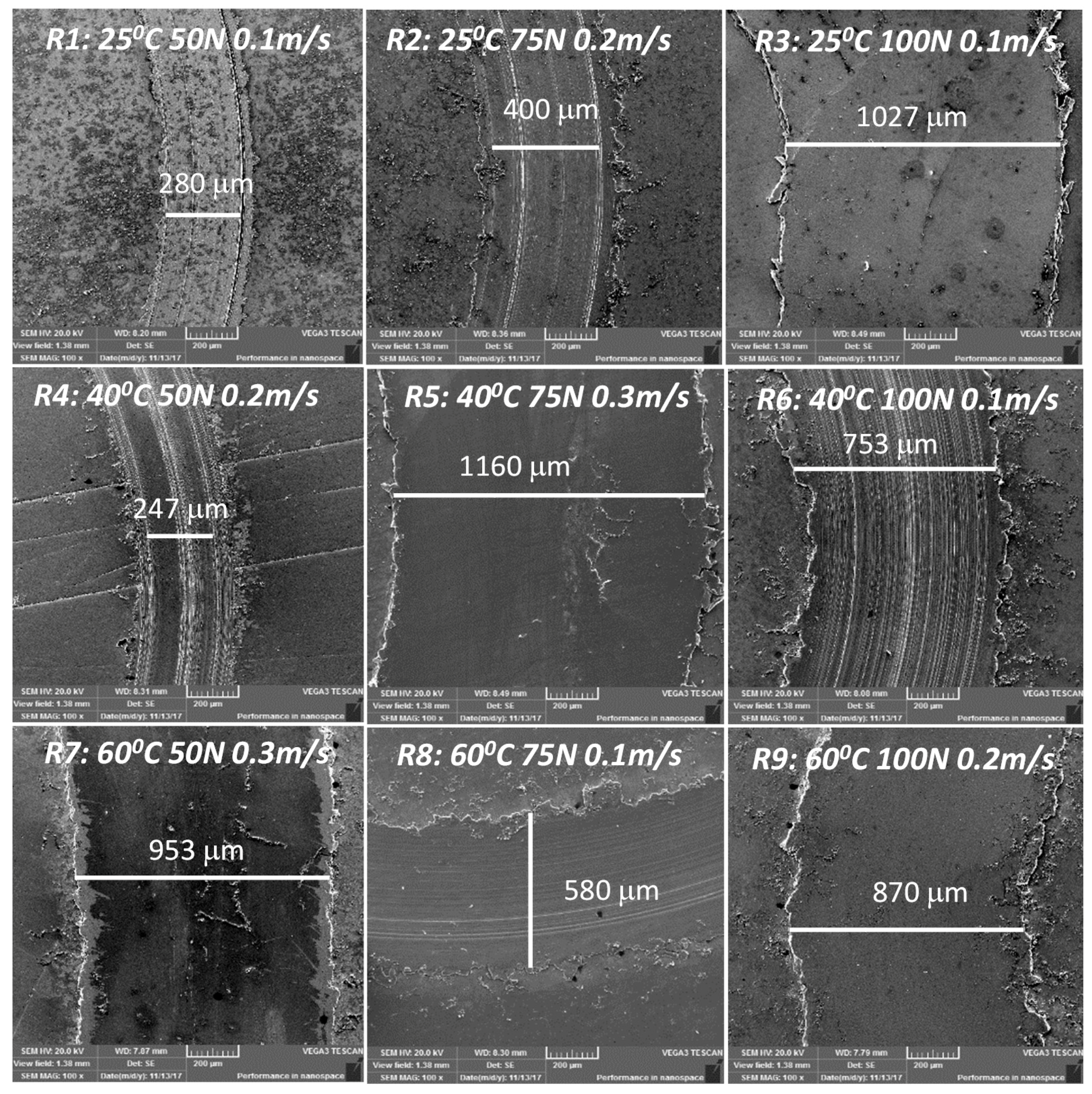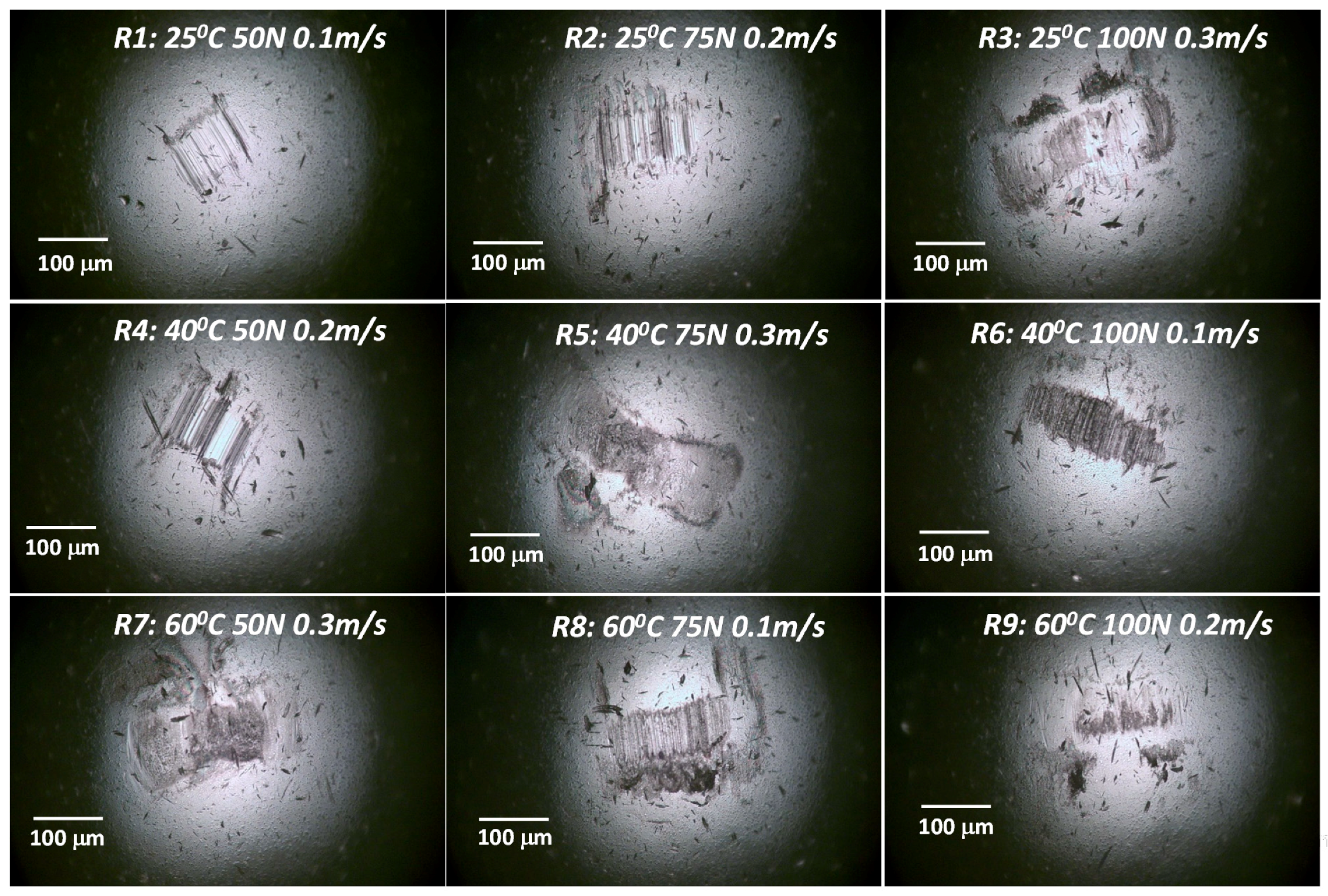3.1. FT-IR Chemical Analysis of DPFS
The FT-IR spectrum of DPFS sample is displayed in
Figure 2, and its respective peak readings are given in the inset table for clarity purposes. In
Figure 2, the broad peak at 3566.2 cm
−1 indicates the presence of a strong hydroxyl group [
24,
25]. The aliphatic −CH2 and −CH3 vibrations are seen between 2604.5 and 3030 cm
−1 [
26]. The peak at 1506.9 cm
−1 is attributed to the stretching mode of (C=O) [
26]. The peak at 1120.3 cm
−1 is related to C−C deviation [
27]. The bands at 900−1300 cm
−1 are assigned to C−O bending modes of saccharides [
28]. The peak at 954.3 cm
−1 is attributed to the −OH group [
29]. The peak at 736.5 shows a rocking vibration of (−CH2−) group [
30]. All the above peaks are characteristic of different fatty acids such as the palmitic acid, oleic acid and linoleic acid which help in improving the anti-wear properties.
3.2. Effect of the Input Variables/Factors on the Specific Wear Rate.
Table 4 shows the response of specific wear rate (SWR) and the corresponding S/N ratio for the three trials of the experiment conducted at each of the combination of the levels of the three factors (Load, Speed and Temperature) for all of the nine runs.
Figure 3a shows the main effects plots for the mean SWR for the different levels of each of the factors and 3b shows the main effects plots for the mean S/N ratios whose criteria in this case is ‘Smaller the better”. All these plots and the statistical analysis are done using Minitab 17 statistical software (Minitab, State College, Pennsylvania, USA). The plots are based on average values of each experimental run, and are used to evaluate the effect of each factor on the performance of DPFS.
It is clear from the main effects plots that the specific wear rate increases with an increase in temperature from 25 to 60 °C, respectively. This can be attributed to the decrease in the viscosity of DPFS as mentioned earlier with an increase in temperature.
It is also observed from the main effects plots that the specific wear rate increases with increasing sliding speed. This can be attributed to the fact that with increased speed, the localized temperature at the point of contact increases which reduces the viscosity of DPFS leading to an increase in the specific wear rate.
However, it can be observed from
Figure 3a that with an increase in the normal load from 50 to 75 N, an insignificant change in the SWR was seen. However, as the normal load increased from 75 to 100 N, there was a significant drop in the SWR. This can be explained by two phenomenon taking place at the higher loads. Firstly, with an increase in the normal load, the asperities of the sample may have got plastically deformed resulting in a smoother surface which in turn contributes to the reduction in the SWR. Secondly, it can be attributed to the formation of an effective tribo film by the fatty acids present in the DPFS as evident from the FT-IR analysis which in turn helps in protecting the contacting surfaces at higher loads which simulates the boundary lubrication regime.
ANOVA analysis was also conducted at 95% confidence level (using a level of significance α = 0.05) to evaluate the contribution of each factor on SWR and are ranked as shown in
Table 5. Based on this analysis, speed was ranked as the highest contributor to the specific wear rate followed by temperature and load as the second and third contributors, respectively. The optimal combination which will result in the lowest SWR comes out be 25 °C, 50 N and 0.1 m/s.
3.3. Effect of the Input Variables/Factors on the Coefficient of Friction
Table 6 shows the response of coefficient of friction (COF) and the corresponding S/N ratio for the three trials of the experiment conducted at each of the combination of the levels of the three factors (Load, Speed and Temperature) for all nine of the runs.
Figure 4a shows the main effects plots for the mean COF for the different levels of each of the factors and 4b shows the main effects plots for the mean S/N ratios whose criteria in this case is ‘Smaller the better”.
It can be observed from the main effects plots for mean COF for the different factors in
Figure 3a that the mean COF increases with an increase in temperature. This can be attributed to the reduction in the viscosity of the DPFS solution with an increase in the temperature which may result in an intermittent metal to metal contact at the contact surface leading to an increase in the COF.
However, with an increase in the normal load from 50 to 75 N, the COF seems to increase. This can be attributed to the fact that at lower contact loads, the DPFS separates the contacting surfaces with little or no asperities’ contact leading to a lower friction coefficient. To elaborate more, the real contact area increases proportionally with load (Ar = W/H, where Ar is the real area of contact, W is the applied normal load, H is the hardness of the softer material), and frictional force increases proportionally to the contact load. However, with a further increase in the load to 100 N, the COF instead of increasing showed a significant decrease. This can be attributed to the extremely high load of 100 N due to which the contact region is deprived of the DPFS lubricant, which may have resulted in the plastic deformation of the asperities with the contact stress going beyond the yield stress of the material, thus resulting in a smoother surface leading to a lower COF and also lower wear rate as presented earlier.
It can also be observed from
Figure 4a that the COF reduced drastically with an increase in the sliding speed from 0.1 to 0.2 m/s and showed a little increase with a further increase in the sliding speed to 0.3 m/s. The decrease in the COF can be attributed to the fact that at slow speeds hardly any lubricant is entrapped between the surfaces resulting in more metal to metal contact due to which the COF may be high, just as in the boundary lubrication regime. However, with an increase in the speed to 0.2 m/s, more and more DPFS lubricant will be pulled in the contact region, resulting in a reduction in the metal to metal contact leading to a reduction in the COF, just as in a mixed lubrication regime. However, the increase in the COF with a further increase in the sliding speed can be because of two reasons—first being that, as the speed increases more, DPFS lubricant will be pulled in the contact region separating the two surfaces completely, resulting in a slight increase in the COF just as in a hydrodynamic lubrication regime. However, it is to be noted that the SWR was higher at 0.3 m/s. Thus, the second and a more plausible explanation could be that, with an increase in speed, there may be a reduction in the viscosity of the DPFS lubricant due to an increase in the localized temperature, leading to a metal to metal contact resulting in an increased COF.
Frictional graphs give a very detailed information about the various processes taking place during the test [
31,
32,
33].
Figure 5 shows typical frictional graphs for the nine runs with the three factors running at different levels according to the L
9 array of the Taguchi design. For most of the cases, the steady state COF is reached almost immediately after a very short running-in period with slight fluctuations. However, for the runs wherein the testing temperature was 60 °C and the load and the speed varied, more fluctuations in the COF graph are observed. This can be attributed to the reduction in viscosity of the DPFS lubricant. Moreover, higher loads simulate a boundary lubrication condition wherein the DPFS does not reach the contact region so as to protect the two mating surfaces. In particular, a higher initial COF is observed for the 9th run (60 °C, 100 N, 0.2 m/s) which could be due to the reduction in the viscosity of DPFS and also due to the higher load because of which a thick film of DPFS lubricant is not formed to separate the two mating surfaces. However, with time, the COF attains a steady state which can be attributed to the formation of a thin low shear strength tribo-film because of the interaction between the carboxylic group which are mainly found in fatty acids and the metallic surface, resulting in improved tribological performance of the DPFS.
ANOVA analysis was also conducted for the friction coefficient and the corresponding signal-to-noise ratio, resulting in the ranking of the factors which significantly affect the COF as shown in
Table 7. The most dominant factor influencing the variation in COF was found to be the sliding speed. The least factor affecting the COF was the normal load.
The performance of the DPFS lubricant under the various conditions was compared to that of results of the sliding wear test of the hardened steel ball against the mild steel sample under dry conditions at a load of 50 N and a sliding speed of 0.1 m/s after 3500 cycles [
19]. It is observed that the wear track depth with DPFS as a lubricant in all the experimental runs was much lower (~15 µm after 10,000 cycles) as compared to that of under dry conditions (~152 µm after only 3500 cycles) signifying the excellent performance of DPFS in protecting the mating surfaces from wear. Moreover, there was also a significant reduction in the COF from ~0.62 under dry conditions [
19] to ~0.1 with DPFS as a lubricant highlighting the efficiency of DPFS lubricant in reducing both the COF and the wear rate.
3.4. Examination of the Wear Tracks and the Counterface Balls Using SEM and Optical Microscopy
On examining the SEM images of the wear tracks as shown
Figure 6, it can be observed that both the wear track width in general increased with an increase in the load and sliding speed. However, on a closer examination of a few specific wear tracks such as that for R6 (40 °C, 100 N, 0.1 m/s), we found that the wear track was relatively rougher. This could be due to a possible metal-to-metal contact, resulting in the ploughing of the softer surface by the asperities of the hard counterface ball and resulting in a SWR of about 0.15 × 10
−6 mm
3/Nm. This could be due to the high load and low speed because of which there is not enough DPFS lubricant in the contact region, suggesting a boundary lubrication regime resulting in a metal to metal contact. However, the moderately low SWR value suggests the efficiency of the DPFS lubricant in protecting the two mating surfaces due to its ability to form a tribo film because of the presence of the fatty acids. Some of the wear tracks were also characterized by smooth surfaces, suggesting wear by plastic deformation as in the case of R9 (60 °C, 100 N, 0.2 m/s). This could be due to the flattening of the asperities in the first few cycles due to the high load and higher temperature whereby the viscosity of the DPFS lubricant reduces considerably. The R9 gave showed again a moderately low SWR of 0.171 × 10
−6 mm
3/Nm and a very low COF of 0.08. Moreover, a very small scar mark is observed on the counterface ball (
Figure 7), suggesting the efficiency of the DPFS lubricant in protecting the mating surfaces.
It is also to be noted that the steel coupons showed a very low wear rate in general under the tested conditions as compared to the wear rates shown by few other vegetable/seed/fruit extract oils as found in the literature.
Table 8 shows a comparison between the wear rates and the COF shown by DPFS and other vegetable oils under almost similar conditions. It can be seen that DPFS’s performance is quite comparable to that of the other oils in terms of wear rates and COF signifying its potential to be used as an environmentally friendly lubricant.
